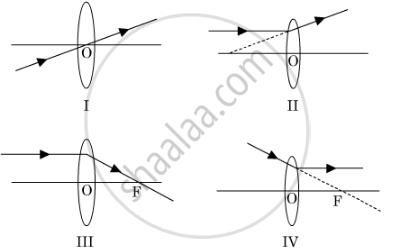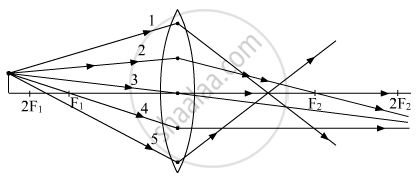Advertisements
Advertisements
Question
What kind of lens can form:
an erect magnified image?
Solution
A convex lens can form an erect magnified image.
APPEARS IN
RELATED QUESTIONS
To find the image-distance for varying object-distances in case of a convex lens, a student obtains on a screen a sharp image of a bright object placed very far from the lens. After that he gradually moves the object towards the lens and each time focuses its image of the screen.
(a) In which direction – towards or away from the lens, does he move the screen to focus the object?
(b) What happens to the size of image – does it increase or decrease?
(c) What happen when he moves the object very close to the lens?
A student has obtained a magnified image of a flame on a screen using a convex lens. To draw the corresponding ray diagram to show the image formation, which of the following two rays whose paths after refraction are shown, should he select ?

(A) I and II
(B) II and III
(C) III and IV
(D) I and III
If the object is moved to a point only 3 cm away from the lens, what is the new position, height and nature of the image?
A student did an experiment with a convex lens. He put an object at different distances 25 cm, 30 cm, 40 cm, 60 cm and 120 cm from the lens. In each case he measured the distance of the image from the lens. His results were 100 cm, 24 cm, 60 cm, 30 cm and 40 cm, respectively. Unfortunately his results are written in wrong order.
Rewrite the image distances in the correct order.
A convex lens forms an image of an object equal to the size of the object. Draw a diagram to illustrate it.
In the following cases, where must an object be placed in front of a convex lens so that the image formed is of the same size as the object?
Out of the five incident rays shown in the figure find the three rays that are obeying the laws of refraction and may be used for locating the position of image formed by a convex lens:
(A) 1, 2 and 3
(B) 2, 3 and 4
(C) 3, 4 and 5
(D) 1, 2 and 4
List four properties of the image formed by a convex mirror.
Where must a point source of light be placed in front of a convex lens so as to obtain a parallel beam of light?
